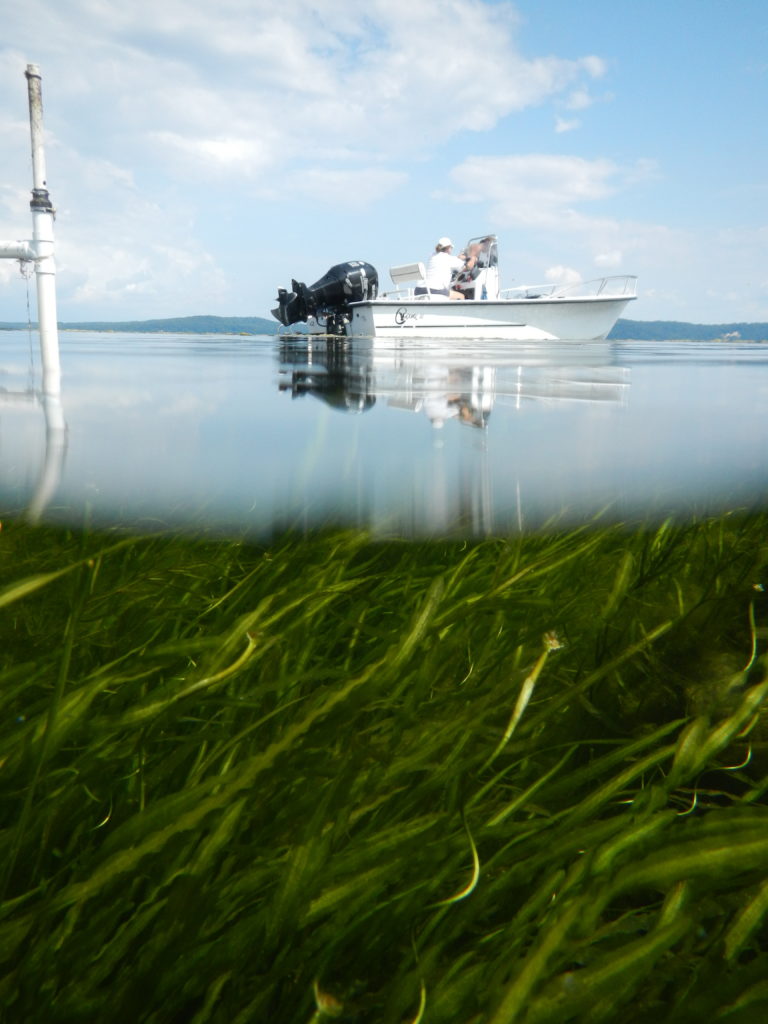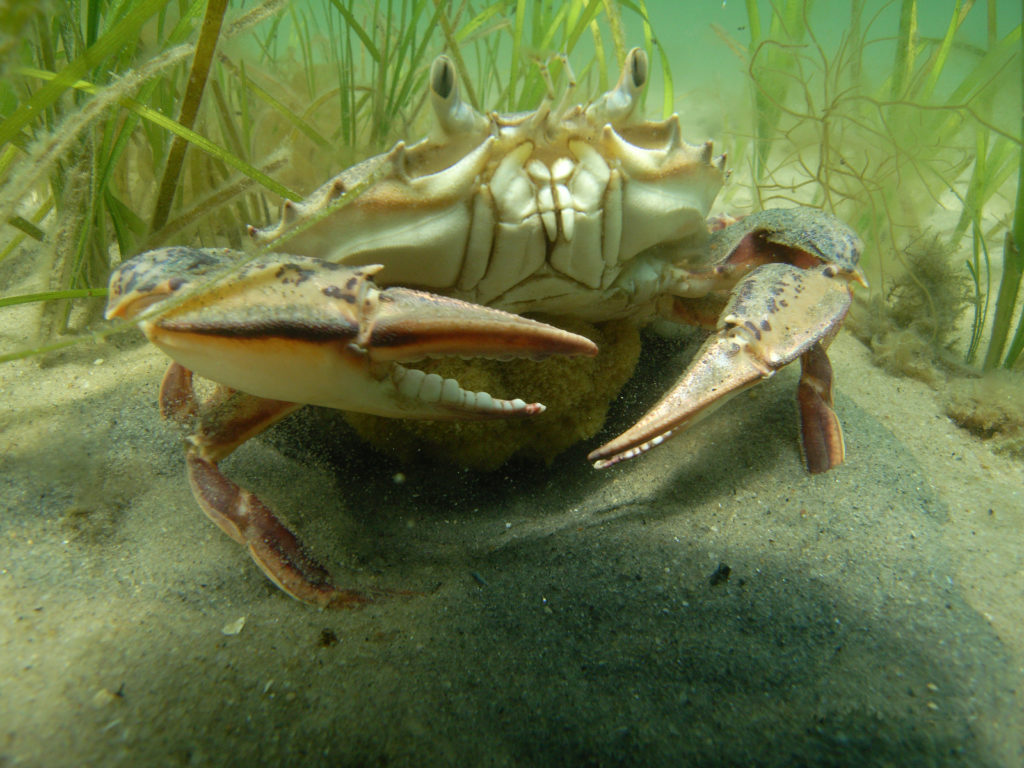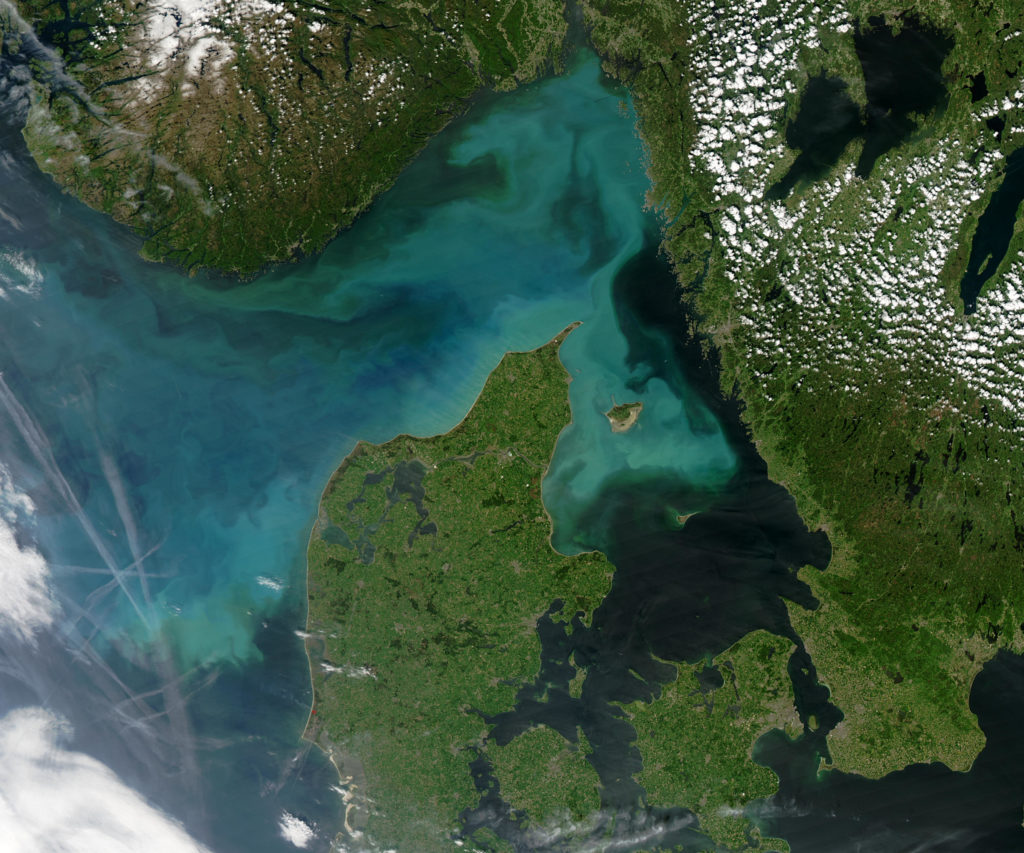by Kristen Minogue

A scientist tests water quality and seagrass biomass on the Susquehanna Flats, in upper Chesapeake Bay. (Cassie Gurbisz)
For a long time, it seemed the odds were never in their favor. With seagrass wasting disease, hurricanes and chronic pollution, tens of thousands of acres of Chesapeake Bay underwater plants vanished between the 1950s and 1970s, marking the largest decline in over four centuries. But now, thanks to concerted efforts to rein in harmful nutrients like nitrogen and phosphorus, underwater flora can celebrate a new victory: the largest underwater grass resurgence ever recorded.
A team of 14 Chesapeake scientists came out with the discovery on Monday, in a new study published in Proceedings of the National Academy of Sciences. The scientists found that since 1984, average nitrogen levels in the Bay have dropped 23 percent, and phosphorus has dropped 8 percent. As a result, underwater plants in Chesapeake Bay have shot up more than four-fold.
This is not only a victory for conservationists. Underwater plants are worth trillions of dollars for society. They protect shorelines from erosion and storm surges, store carbon, and provide food and shelter for some of the Bay’s most popular species, including young blue crabs. But more than that, they are “sentinel species,” a gauge of the overall health of Chesapeake Bay.
“Big increases in the grasses mean that we’re really succeeding in our effort to restore the Chesapeake Bay—that we’re getting sediment and the nutrients down to levels where the water’s clearer and the grasses get the light they need to survive and grow,” said co-author Don Weller, an ecological modeler with the Smithsonian Environmental Research Center. “Cleaner water and more grasses should also support other things that we used to have more of in the Bay, like crabs and oysters.”

A female crab takes shelter in eelgrass. Chesapeake Bay’s underwater grasses provide habitat to blue crabs and many other popular species. (NOAA)
Managers have long suspected that cutting nutrient pollution held the key to restoring underwater grasses, and by extension the whole of Chesapeake Bay. In their data, phosphorus-fueled algal blooms clouded the water, slowly starving the grasses of light, while nitrogen fostered algae that attached to grass, again blocking light. Sources of nutrient pollution are legion: fertilizers from farms and lawns, sewers, septic systems and other forms of urban and suburban runoff.
In 1983, policymakers banded together to clamp down on nutrients by forming the Chesapeake Bay Program. The partnership includes the Environmental Protection Agency, the District of Columbia and the six states in the Chesapeake Bay watershed.
To see how well those efforts paid off, the scientists pooled over 30 years’ worth of data. They looked at aerial surveys of grass beds and nutrient levels in the Bay from 1984 through 2015. They looked at historical records of land use—whether certain areas had cropland, forests or buildings—and how much fertilizer they were applying.
“These efforts began before I was even born,” said Jonathan Lefcheck, the study’s lead author and marine ecology postdoc at the Bigelow Laboratory for Ocean Sciences. “But we are at a stage now where all these different threads can be pulled together to unveil a picture of unprecedented success.”
The team crunched the numbers in two ways. One analysis looked at 120 smaller subestuaries within the Bay, to show how land use and nutrient sources in the local watersheds of the subestuaries impact underwater plants. The other analysis connected nutrient levels in Bay water to nearby plants throughout the entire Bay.
Both methods showed that the fate of underwater grasses is directly tied to nutrient pollution. The plants lost ground in times and places where more nutrients streamed into the Bay, primarily from agriculture and urbanization. That strong link also meant the plants’ four-fold recovery stemmed from the overall decline in Bay nutrients over the last three decades.
This means the Chesapeake Bay Program and the EPA pollution diet are working, according to William Dennison, a co-author with the University of Maryland Center for Environmental Science. Not only that, but their efforts “can serve as a model for the rest the world.”

Phytoblankton bloom. Excess phosphorus in the Bay can create massive blooms of algae on the water, which block light from underwater plants and can drain the water’s oxygen. (NASA)
The team also discovered something they did not expect: the power of biodiversity. The greatest recoveries occurred in areas where more than a dozen plant species flourished. Across the entire Bay, biodiversity averaged three species in any single site. According to the team’s estimates, even adding just one species to that mix could nearly double the grasses’ territory.
The battle is far from over. According to the Chesapeake Bay Program’s 2017 Bay Barometer, underwater grasses now cover roughly 97,000 acres of the Bay floor, which is still just above half of the ultimate goal of 185,000 acres. But now, finally, there’s proof that the Bay’s three-decade nutrient diet is bearing fruit.
“This is a message of hope,” said Lefcheck. “And I look forward to a future when the Bay is filled with grasses, something I never thought I would see during my lifetime!”
This study was a collaborative effort among the Bigelow Laboratory for Ocean Science, the Virginia Institute of Marine Science, the University of Maryland Center for Environmental Science, the U.S. Environmental Protection Agency, the Smithsonian Environmental Research Center, the U.S. Geological Survey, the National Socio-Environmental Synthesis Center, St. Mary’s College of Maryland, the U.S. National Park Service, the Maryland Department of Natural Resources and Texas A&M University Corpus Christi. The full study is available at http://www.pnas.org/content/early/2018/02/27/1715798115.

